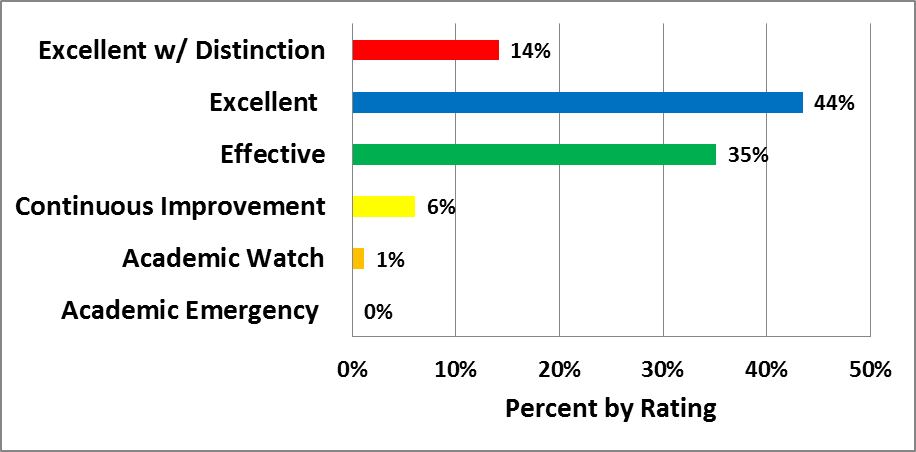In Ohio’s recent waiver application to the U.S. Department of Education for relief from the most onerous portions of the federal No Child Left Behind Act the Buckeye State proposes the creation of a revamped and significantly improved reporting system for school and district performance.
Ohio’s current rating system uses vanilla terms for rating schools and districts like “Excellent with Distinction,” “Continuous Improvement,” and “Academic Emergency.” Worse, the state’s rating system provides inflated grades for performance. For example, in classic Lake Wobegon fashion, 57 percent of Ohio’s school districts were rated as “Excellent with Distinction” or “Excellent” (the best possible ratings) in 2011. Conversely, not one of the state’s 609 rated school districts was rated “Academic Emergency” (the lowest possible rating).
Ohio’s new system would incorporate an A-F letter grade system, and grades would be based on a basket of performance metrics ranging from number of academic standards met or surpassed to value-added gains to progress in closing achievement and graduation gaps. Under the proposed new system – which has to be approved by the U.S. Department of Education and put into Ohio law – districts and schools will be provided with an overall grade and separate grades in the categories of: 1) student performance, 2) school performance, 3) gap closing and 4) student progress (see details here).
The proposed changes would not only be easier for parents, citizens, and others to understand because it will use the old education staples of A-F ratings, but the grades promise to be better gauges of actual school and district performance. State Superintendent Stan Heffner has shared that “Parents won’t see as many As” on school report cards,” which means parents, taxpayers, and others will be given a more honest appraisal of actual district and school performance. This would undeniably be a step forward for Ohio, its children, and its schools in that the first step to improvement is acknowledging you’ve got a problem or weaknesses to improve upon.
Using data provided earlier this week by the Ohio Department of Education we have summarized how school districts and schools across the state would be rated using the current system and using the proposed new system. It should be noted that the data simulations were created using actual performance data from 2011 and do not project into 2012. These are not a prediction of future scores, but rather a way to compare recent results under the two different systems. What’s clear from the charts below is that Ohio would see a more balanced, and we think more honest, rating system under the proposed changes.
For example, under the new system only three percent of Ohio’s school districts would receive an A grade, which is a stark contrast to the nearly 60 percent of school districts in Ohio that received a top rating of Excellent or Excellent with Distinction in 2011. Conversely, whereas no school districts fell into Academic Emergency in 2011, under the new system two districts would receive an F.
Graphs 1 and 2 below demonstrate results under the current system and how things would potentially change under the proposed A-F system.
Graph
1: Academic Ratings for Ohio’s School Districts Under Current System
(Using 2010-11 Performance Data)

Graph
2: Academic Ratings for Ohio’s School Districts Under Proposed System
(Using 2010-11 Achievement Data)

The same kind of shift in performance rating can be seen among individual school buildings across the state (there are about 3,400 public district and charter schools in Ohio that receive academic ratings). Graph 3 shows the percentage of schools by each current academic designation. Again, the Excellent and Excellent Distinction range is inflated. However, graph 4 shows that the distribution changes significantly under the proposed system. Under the new system there would be as many schools rated F as there are rated A.
Graph
3: Academic Ratings for Ohio’s Public Schools Under Current System
(Using 2010-11 Achievement Data)

Graph
4: Academic Ratings for Ohio’s
Public Schools Under Proposed System
(Using 2010-11 Achievement Data)

Ohio’s planned move away from its current rating system to the proposed A-F system is an improvement, a more honest and accurate description of how Buckeye schools and districts are actually performing. The decline in the number of Excellent and Excellent with Distinction schools and school districts would likely come as a shock to many district officials, school principals, teachers, parents, and students. And, there will surely be much clamoring to water down the system as happened in the past, but moving forward is the right thing for the Buckeye State, its schools, and its children. The Ohio Department of Education deserves kudos for seeking to use the NCLB waiver process to elevate school expectations in Ohio. Hopefully the USDOE will approve the waivers quickly and without modifications, while Ohio’s General Assembly passes the legislation necessary for the state to move forward.

